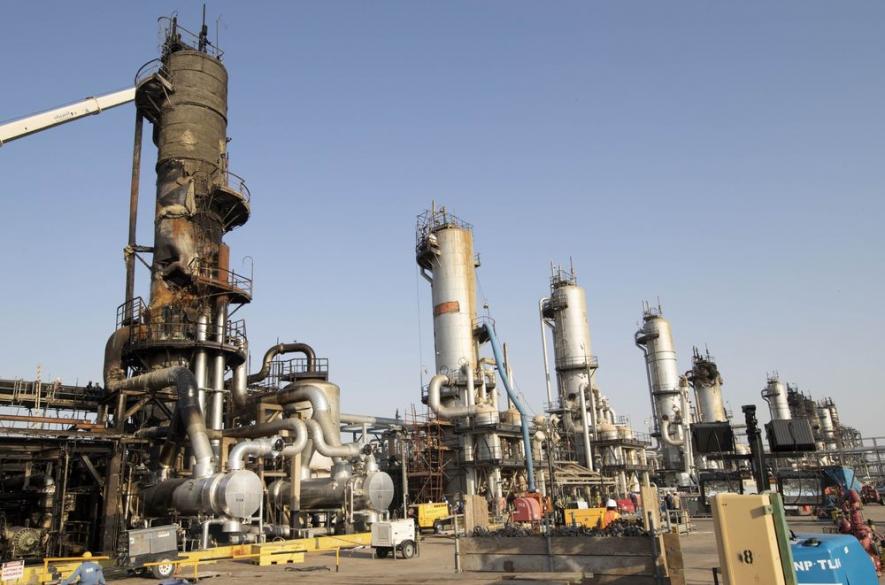Will Saudi Aramco Invest in India During Ongoing Crippling Oil Price War?

Image Courtesy: Bloomberg
Before the ongoing oil price war brought about by the novel coronavirus pandemic, Aramco of Saudi Arabia had appeared keen on investing in India’s downstream petroleum refining companies owned by the government, as well as in the country’s single largest private corporate entity, Reliance Industries Limited (RIL).
The impending global recession has raised doubts about whether these investment intentions of the Saudi Arabian company, with deep pockets, would fructify. Preceding the ongoing economic chaos, why did the Narendra Modi government curiously decide to take on the company led by the country’ richest man, Mukesh Ambani?
During his visit to India in 2019, Saudi Crown Prince Mohammad bin Salman (MBS) had announced that his country would invest $100 billion or more in India in the next two years. However, with the crippling oil price war fought by Russia and Saudi Arabia, the de facto leader of the Organisation of Petroleum Exporting Countries (OPEC), the prospects of Aramco investing in India––either in Reliance or in the country’s second-largest public sector oil refining and marketing company, Bharat Petroleum or, for that matter, in the proposed mega refinery and petrochemicals complex in Maharashtra being set up by three government-owned oil companies––have dimmed considerably.
It is doubtful if the world market for crude oil will improve soon for foreign companies to purchase stakes in India’s downstream oil companies. Whereas only a fool will hazard guesses about the future of oil prices or, for that matter, the intentions of MBS and Russian President Vladimir Putin, it may be useful to take a look at what happened in the past to find pointers to what may happen in the foreseeable future.
Past Oil Wars and Price Shocks
During the last half-century, there have been three key oil ‘shocks.’ The first was the Arab oil embargo in 1973. Then, in 1977-78, came the overthrow of the Iranian government and the war with Iraq. In 1991, Iraq attacked Kuwait. On all these three occasions, prices of crude oil jumped.
Since the formation of OPEC in 1960, there have been four major global oil-price ‘wars.’ In 1986, crude prices fell below the single digit mark. In 1997, when the Saudis were upset with Venezuela flooding the American market with oil, prices halved from $20 a barrel. Then, between 2014 and 2016, global prices fell from $115 a barrel to as low as $26 a barrel. In 2014, the US was desperate to gain a larger share in international energy markets while Saudi Arabia wanted to stymie the shale ‘revolution.’
And, now, prices in the last week of March, have fallen to around $20 a barrel from a recent peak of $65 a barrel. This latest collapse in crude oil prices, which has been brought about by the spread of the coronavirus, is arguably the worst in living memory, not so much in terms of the quantum of the fall in prices but by its wider economic implications in the context of the worldwide recession.
Until the formation of OPEC, it was the seven sisters—comprising major oil companies like Exxon, Chevron, Shell, British Petroleum and Standard Oil—that controlled crude oil production and its prices. A few years after OPEC came into existence, it started to exert considerable control over world crude prices.
However, when demand exceeded supply—because of disruptions of the kind that took place in 1973 (first oil shock) and in 1977-78 (second oil shock)—OPEC just followed higher world oil prices. Its ability to influence global crude oil prices diminished over time, especially with the rise in oil and gas exports from Russia.
The first three world oil price wars were initiated by Saudi Arabia. When other OPEC members did not follow quota discipline and Saudi production fell to uncomfortably low levels, the Saudis would open the tap to gain market share. Other OPEC members had to agree to limit their production quotas.
In 2014, to increase market share, Saudi Arabia started the third world oil price war to compete with US shale oil producers. The country also wanted to stop ‘freeloading’ by non-OPEC members and this resulted in prices dropping to $26 a barrel.
To the surprise of the Saudis and also other OPEC members, US shale oil production continued to increase. The Saudis expected that when oil prices fell to $70 a barrel, supposedly the ‘break-even’ price, American shale oil production would get curtailed. But that did not happen.
Competition to Collaboration
It is always a crisis that forces competitors to cooperate. In 2016, OPEC sought, and was able to gain, support from other oil exporting countries, led by Russia, to form OPEC+, which managed to stabilise the price of crude oil in the range $50-70 a barrel—until, that is, the black swan event of the coronavirus outbreak.
In between these oil shocks and price wars, there was concern until a few years ago that the world was running out of oil by a few ‘peak oil’ pundits. The new buzz phrases are ‘peak demand’ and the impact of ‘energy transition’ when fossil fuels are replaced by renewable sources of energy. We think that oil reserves may be stranded.
Given that the overall global economic situation has become particularly uncertain, it is not going to be easy for oil companies to do long-term planning. In August 2019, Reliance Industries Limited announced its intention to sell a 20% stake in its oil and chemical business to Saudi Aramco for $15 billion. It was expected that the deal would be implemented by March 2020.
This was supposed to be a win-win situation for Reliance and Aramco. Reliance would have been able to reduce its huge debt (to become a zero-debt company by 2021) while Aramco would have found an outlet to market its oil. The non-binding agreement that was signed provided for Aramco supplying between 500,000 barrels and 700,000 barrels each day on a long-term basis.
Oil exporting countries like Saudi Arabia were looking at India because it was unlikely that oil demand in the country would peak in a hurry. As in the 1960s, when international oil companies were facing difficulties in marketing crude, until recently it was perceived that investing in downstream oil refining and marketing companies in India would be a good business proposition.
Aramco Has to Choose Between Reliance and the Public Sector
Even before Reliance was looking for a buyer for a stake in its petroleum division, 2015 onward, India’s three major public sector oil companies -- Indian Oil Corporation (IOC), Bharat Petroleum Corporation Limited (BPCL) and Hindustan Petroleum Corporation Limited (HPCL) -- had been negotiating with Aramco and the Abu Dhabi National Oil company (ADNOC) to invest in a mega 60 million tonnes per annum capacity refinery-cum-petrochemicals chemical complex. The public sector oil companies would hold a 51% share in the new complex.
The original cost estimate for the complex that is to be set up in Ratnagiri, Maharashtra, was $44 billion in April 2018. This figure was revised upward to $60 billion in August 2019. Many had argued that if Aramco had to choose between investing in Reliance and in the public sector refining-cum-petrochemicals complex, it would opt for the latter on purely commercial considerations.
However, in all large transactions of this nature, it is not economics but geopolitics and personal relationships that prevail. Given the excellent relations between Prime Minister Modi and Crown Prince MBS, it was a toss-up as to which investment would be made first by Aramco.
There was another important factor. The Reliance refinery complex at Jamnagar, Gujarat, is a highly complex one that has been built to handle the ‘worst’ possible crude oil (extra-heavy oil with high sulphur content) in the world. This gives it an unusual advantage: it is able and willing to buy different grades of crude oil from different sources at attractive prices to generate high profits.
Venezuelan crude is said to be among the ‘worst’ and extra-heavy, whereas Saudi crude is heavy and with high sulphur content––and importantly, is priced lower when it lands in Indian ports.
After the shale oil boom, many American refineries faced constraints since they were converted to handle heavy ‘sour’ oil to exploit the increasing price gaps between shale oil and conventional crude. Since shale oil is sweet, the US has been exporting light sweet oil and importing heavy sour oil.
Thus, Reliance’s Jamnagar refinery complex may prefer the Venezuelan-type, lower-priced crude oil rather than Saudi crude and this may create conflicts of interest between Aramco and other stakeholders in the Reliance complex.
According to Union Petroleum Minister Dharmendra Pradhan, Prime Minister Modi strongly believes that “it is not the business of the government to be in business.” This was supposed to be the ‘real’ reason for the government’s decision to sell its 53% stake in BPCL in 2019, though the ‘unstated’ objective is to lower the fiscal deficit.
Any strategic investor in BPCL would get access to BPCL’s 37 million tonnes of refining capacity and access to 15,000 retail outlets. Again, for an upstream company like Aramco that is interested in finding an outlet for its crude oil in an era of peak demand, investing in BPCL would be an ideal decision.
Aramco would also not have any conflict of interest in processing its crude oil in BPCL’s refineries, which cannot refine Venezuelan crude. An astute bureaucrat from the Union Ministry for Petroleum and Natural Gas could have approached Aramco to explore the possibility of it buying a stake in buying BPCL instead of putting spokes in Reliance’s efforts to sell its stake to the Saudi Arabian company.
Government Putting Spokes in Reliance’s Wheel?
Instead, in September 2019, barely a month after the Reliance-Aramco memorandum of understanding (MoU) was announced, the government approached the Delhi High Court and obtained a stay order on the proposed sale of stake by Reliance. The government claimed that Reliance owed it $4.5 billion based on an award pertaining to a production-sharing contract relating to the Panna-Mukta-Tapti (PMT) oil and gas fields that went against Reliance, Shell and British Gas Corporation.
There was also another tribunal award of $2 billion against Reliance for “undue enrichment” by using gas flowing from a block adjacent to the one contracted for exploitation to the Indian public sector upstream Oil and Natural Gas Corporation (ONGC) in the Krishna-Godavari (KG) basin in the Bay of Bengal off the coast of Andhra Pradesh.
One is not arguing here that the government was not justified in trying to get a stay order against dues claimed from Reliance. In the KG basin, experts had suggested ‘unitisation’ to avoid future litigation and this would also have been the right thing to do. All over the world, when a discovery of oil or natural gas is made and reserves may be lying in two adjacent blocks, it is customary to develop the field based on the principle of unitisation. However, this was not done by the Congress-led United Progressive Alliance (UPA) government contributing to the dispute between ONGC and Reliance.
Irrespective of the claims and counter-claims in both the KG basin and the PMT fields, the question was one of timing. Was it a judicious move on the part of the Petroleum Ministry to attempt to get a stay order against Reliance and its multinational associates when international arbitration tribunals were yet to be conclude their deliberations and final awards/judgments were yet to be delivered?
Is there more to this move to move court than meets the eye? Is there any basis to the speculation that the Modi government wanted to show the Reliance boss, India’s richest man Mukesh Ambani, his place?
It can be contended that India needs a large investment from Aramco, be it in Reliance or in BPCL. It can be further argued that foreign investment need not come from Aramco alone but also from Abu Dhabi’s ADNOC, Kuwait and Qatar.
But none of this will happen before the economy of the world and that of India stabilises. With oil prices having collapsed, that time is yet to come.
Writing assistance: Paranjoy Guha Thakurta
Dr Bhamy V Shenoy is a former manager for Conoco and a former director of the National Oil Company of Georgia. The views are personal.
Get the latest reports & analysis with people's perspective on Protests, movements & deep analytical videos, discussions of the current affairs in your Telegram app. Subscribe to NewsClick's Telegram channel & get Real-Time updates on stories, as they get published on our website.























